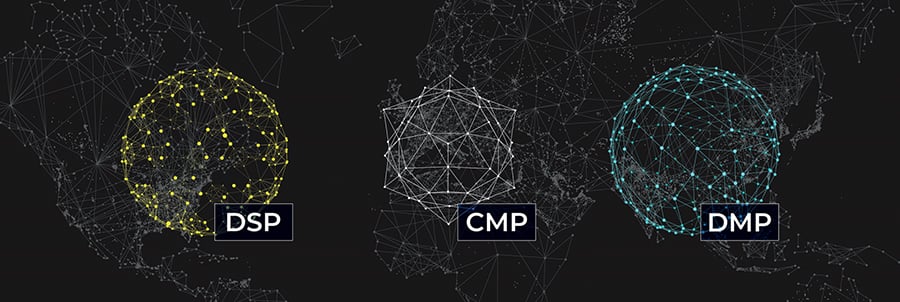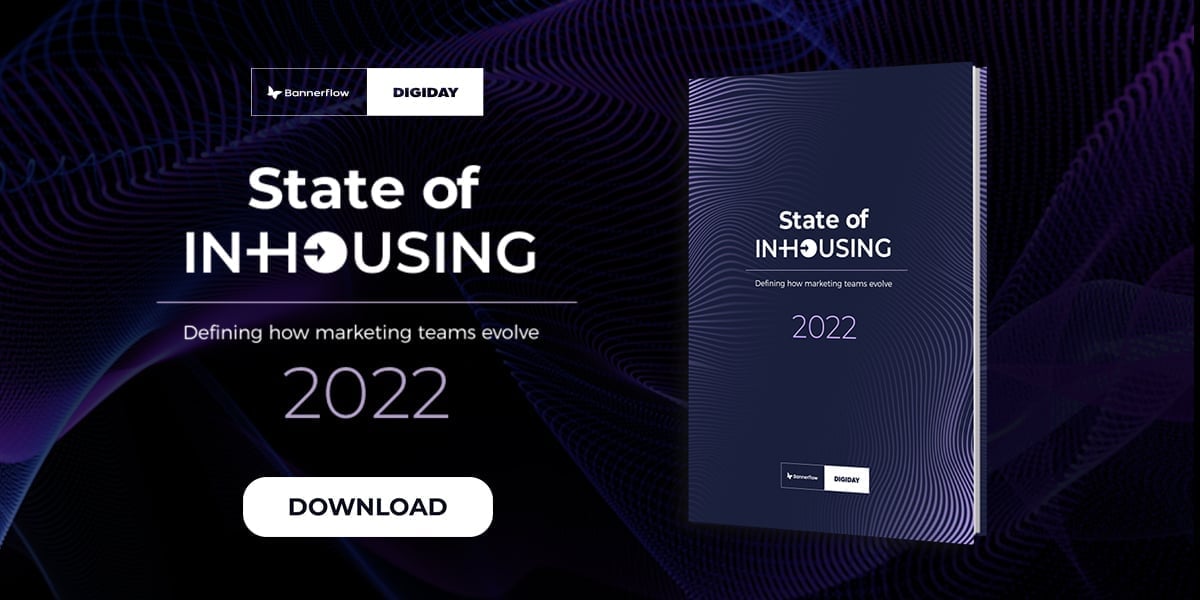DMPs, or data management platforms, should be at the heart of your digital advertising. They enable campaign strategies which improve ad performance and offer valuable actionable insights. Marketing teams simply cannot afford not to use a DMP.
In this blog, we’ll explain what DMPs are and why you need to combine them with demand-side platforms (DSPs). Plus, the benefits both offer digital advertisers when used in conjunction with a creative management platform (CMP).
But first, a brief explanation…
What is a data management platform (DMP)?
Data management platforms are ad tech that collates, stores, and analyses customer data. They provide companies with in-depth insights into their audience segments by tracking the countless bytes of data flying back and forth online.
DMPs find connections between first-party, second-party, and third-party data, which originate from both online and offline sources. The data includes IP addresses, customer information, analytics, device or browser identifiers, and cookie IDs.
How do data management platforms work?
A data management platform collects audience data by tagging pages with trackers to identify who visited certain pages. It integrates with other sources, such as customer relationship management (CRMs), ad exchanges, and demand-side platforms (DSPs). It then adds a tag – usually a JavaScript snippet or HTML pixel – to a website to import data.
A DMP allows its users to create audience segments by grouping or excluding viewers by activity and characteristics. DMPs collect first-party data for marketers to target their own audience segments or they can aggregate third-party data to share with other marketing systems. You can expand your reach by using information gathered from several sources to select and target specific segments for different purposes. For example, media buying and targeted advertising.
If you’re keeping up to date with privacy regulations, you’ve probably heard of the dramatic sounding ‘death of the third-party cookie’. Already blocked on Firefox and Safari, third-party cookies will be banned on every browser by the end of 2024. Since DMPs rely on cookies and mobile identifiers, how will data management platforms work in the post-cookie world?
Times are changing. Marketers need to find new ways to identify audience segments if they want to survive this seismic shift. The good news is that first-party cookies aren’t affected by the new regulations – and they are more reliable than third-party data. First-party data is rich with information about demographics and the customer journey both online and offline. For example, registration forms, point-of-sale data, surveys, and website browsing analytics are all types of first-party data.
DMPs can collate unique first-party information – spanning everything from their age to the current weather in their location – and connect it to a personal identifier, such as a cookie ID. This data allows companies to build segments that can be referenced to target with personalised ads.
Marketers can engage with customers directly to generate accurate data and build stronger relationships based on consent, transparency, and trust.
Why are they useful?
Essentially, DMPs help brands to manage and activate their data. What’s more, they offer brands the tantalising prospect of combining first party and third party data to create specific target audiences. Expanding a campaign’s reach and offering the potential of hyper-targeted messaging.
Why should marketers use DMPs?
As mentioned, DMPs make data accessible and actionable. They use big data and artificial intelligence algorithms to allow for a high level of ad personalisation.
Data management platforms really shine when it comes to:
- Campaign targeting – can open you up to new audiences and customers
- Custom audiences and audience segmentation – the ability to integrate different sources of data into one centralised system
- Personalisation – leveraging real-time data to deliver a personalised experience across multiple channels and increases revenue
Above all, DMPs lay the foundations for data-driven marketing. The data provides insight into customer motivations, preferences, and behaviours. Marketers can use the data to create customer profiles, enhance customer experience, target potential viewers, and predict future behaviour and trends.
In a post-GDPR world, they allow marketers to create a profile they wish to target. These audience segments can include customer information, demographics, household income, past browsing behaviour, purchasing information, location, and device, etc. A DMP can also analyse how those segments performed once an ad is served.
The pay-off? Higher engagement and an increased return on investment. All because the DMP helps you put the right ad in front of the right person – even if you don’t necessarily know who the individual viewer is!
Better yet, if marketers use a customer relationship management system (CRM) – which tracks a brand’s registered customers – with a DMP, they can target both registered and unregistered customers. Integrating real-time data from multiple sources gives you a 360-degree view of your audience and helps to inform, adapt, and scale advertising strategies.
One more thing: think independently
It is best practice to work with an independent DMP. This means you can change DSP, agency, ad server – wherever you are activating data – without being tied down and restricted by a third-party. If you work with a DMP controlled by a media agency, or DSP, you might find yourself in a much less flexible position than you would like.
Essentially, you lose transparency and total control over your data.
Ok, but what about a demand-side platform (DSP)?
Now here’s where things get interesting.
For those who don’t know (or can’t be bothered to look at Wikipedia) a demand-side platform (DSP) is a software for automated ad buying. By using a DSP advertisers can buy inventory through a process known as real-time bidding (RTB). It is a system that allows buyers of digital advertising inventory to manage multiple ad exchange and data exchange accounts through one interface.
They essentially do one thing, and that’s automate and optimise media buying. Combined with a DMP they provide yet more powerful opportunities for digital advertisers.
Why combine a DMP with a DSP?
Combining the functionality of a DSP with the insights of a DMP is a no-brainer. By linking a DSP to a DMP it’s possible to use its data to make more informed choices when buying ad inventory. It allows you to reach the full potential of your data.
You don’t have to limit a DMP to just one DSP either. Connecting a DMP to multiple DSPs expands the range of placements an advertiser can access.
DMPs are used by publishers too. They use DMPs to enhance their inventory offerings for advertisers. In fact, a whole range of other digital advertising players from media agencies to ad networks use DMPs.
How does this benefit digital advertising?
One of the principal benefits of connecting a DMP to your DSP/s is that it maximises the data you have to serve and buy ads. By building individual user profiles you can target ad spend more appropriately; serving viewers with messages based on attributes.
What’s more, you have access to improved data management. A synced DMP will communicate with a DSP over which inventory to buy and which creative to serve in real-time. Plus, the result is measured too, with the DMP learning from the success of the ad. This analysis is then fed into the DSP to optimise the buying process. Indeed, the process offers digital advertisers efficient campaign performance.
Indeed, many digital marketers benefit from a connection between a DSP and a DMP (with many DSPs also using a DMP) but fewer marketers are using a DMP in collaboration with an ad server or CMP. This is a lost opportunity and marketers must look towards further integration for even greater benefits.
Why combine both with a creative management platform (CMP)?
If combining a DMP to a DSP is a no brainer, then connecting both of these to a CMP is something else altogether! According to research carried out by Amazon, up to 97% of programmatic campaigns still don’t use personalised creatives. This means even if an ad is successfully seen by a viewer, it is generic and impersonal.
Imagine data, media buying, and creative production, all rolled into one to create hyper-relevant, real-time, optimisable ad campaign. Well, that’s what we’re talking about when you combine a DMP with a DSP, and a CMP! It means you can create targeted messages for each of your audience segments and better engage audiences through dynamic campaigns.
For example, you can enable user-journey campaigns by integrating your DMP into dynamic creatives. From one banner template, built and controlled via a CMP, you can serve dynamic creatives relevant to where the user is in the sales funnel. Furthermore, a DMP, in combination with a DSP and CMP, can help re-engage users, by serving a particular viewer with the products or offers that interests them.
Conclusion
DMPs, or ad tech that offers similar functionality, is growing in usage. Furthermore, in a post-GDPR world being able to target the right ad, to the right viewer is a valuable asset. The likelihood is that if you’re not yet using a DMP you are at a disadvantage to competitors who are.
Finally, knowing is one thing but having the tools to do remarkable ad campaigns is another thing altogether. Creating DMP linked programmatic dynamic campaigns is not the stuff of agencies – you can do it in-house.
Thanks to the unique capabilities of the creative management platform technical processes and workflows are simpler to implement. If you would like to find out how then please get in touch with Bannerflow.











